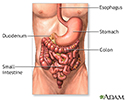Fecal smear
Stool smearFecal smear is a laboratory test of a stool sample. This test is done to check for bacteria and parasites. Presence of organisms in stool shows diseases in the digestive tract.
How the Test is Performed
A stool sample is needed.
There are many ways to collect the sample. You can collect the sample:
- On plastic wrap: Place the wrap loosely over the toilet bowl so that it is held in place by the toilet seat. Put the sample in a clean container given to you by your health care provider.
- Into a plastic container the lab may give you.
- In a test kit that supplies a special toilet tissue: Put the sample in a clean container given to you by your provider.
Do not mix urine, water, or toilet tissue with the sample.
For children wearing diapers:
- Line the diaper with plastic wrap.
- Position the plastic wrap so that it will prevent urine and stool from mixing. This will provide a better sample.
- Put the sample in a container given to you by your provider.
Make sure you follow your provider's instructions for returning the sample. Return the sample to the lab as soon as possible.
The stool sample is sent to a lab where a small amount is placed on a slide. The slide is placed under a microscope and checked for the presence of bacteria, fungi, parasites, or viruses. A stain may be placed on the sample that highlights certain germs or cells under the microscope.
How to Prepare for the Test
There is no preparation needed.
How the Test will Feel
There is no discomfort.
Why the Test is Performed
Your provider may order this test if you have severe diarrhea that will not go away or that keeps returning. The test result may be used to select the correct treatment such as specific antibiotics.
Normal Results
A normal result means there are no disease-causing germs or abnormal cells present.
Normal value ranges may vary slightly among different labs. Talk to your provider about the meaning of your test results.
What Abnormal Results Mean
An abnormal result means that abnormal germs or cells have been found in the stool sample. This may be due to an infection of the digestive tract.
Risks
There are no risks associated with a fecal smear.
References
Fleckenstein JM. Approach to the patient with suspected enteric infection. In: Goldman L, Cooney KA, eds. Goldman-Cecil Medicine. 27th ed. Philadelphia, PA: Elsevier; 2024:chap 262.
Melia JMP, Sears CL. Infectious enteritis and proctocolitis. In: Feldman M, Friedman LS, Brandt LJ, eds. Sleisenger and Fordtran's Gastrointestinal and Liver Disease. 11th ed. Philadelphia, PA: Elsevier; 2021:chap 110.
Siddiqi HA, Rabinowitz S, Axiotis CA. Laboratory diagnosis of gastrointestinal and pancreatic disorders. In: McPherson RA, Pincus MR, eds. Henry's Clinical Diagnosis and Management by Laboratory Methods. 24th ed. Philadelphia, PA: Elsevier; 2022:chap 23.
Wojewoda CM, Stempak LM. Medical bacteriology. In: McPherson RA, Pincus MR, eds. Henry's Clinical Diagnosis and Management by Laboratory Methods. 24th ed. Philadelphia, PA: Elsevier; 2022:chap 57.
-
Lower digestive anatomy - illustration
Food passes from the stomach into the small intestine. In the small intestine all nutrient absorption occurs. Whatever has not been absorbed by the small intestine passes into the colon. In the colon most of the water is absorbed from the food residue. The residue is then eliminated from the body as feces.
Lower digestive anatomy
illustration
-
Lower digestive anatomy - illustration
Food passes from the stomach into the small intestine. In the small intestine all nutrient absorption occurs. Whatever has not been absorbed by the small intestine passes into the colon. In the colon most of the water is absorbed from the food residue. The residue is then eliminated from the body as feces.
Lower digestive anatomy
illustration
Review Date: 6/11/2024
Reviewed By: Jenifer K. Lehrer, MD, Department of Gastroenterology, Aria - Jefferson Health Torresdale, Jefferson Digestive Diseases Network, Philadelphia, PA. Review provided by VeriMed Healthcare Network. Also reviewed by David C. Dugdale, MD, Medical Director, Brenda Conaway, Editorial Director, and the A.D.A.M. Editorial team.



